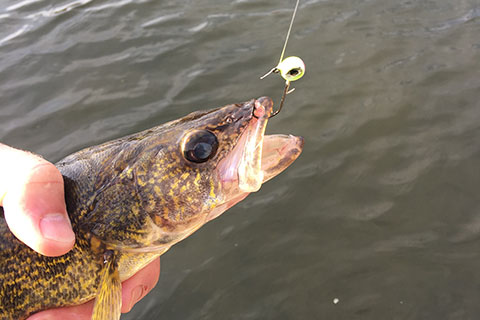On Tuesday, April 17, I had the pleasure of presenting a seminar to an awesome bunch of kids: the Lakeville High School Fishing Club. Team coach Dave Schueck invited me to Lakeville South High School, and the 40 kids plus parents grilled me with great questions. The team members proudly sported their new jerseys, thanks to sponsor Alumacraft, and the questions were focused and serious.
Topics bounced from walleye tips for a Canada trip to summer bass-casting techniques, but I want to focus on something a little more seasonal: spring river fishing.
Several kids asked about fishing the Mississippi River, and clearly border waters is the only open-water game in Minnesota right now. With the recent shift into a normal weather pattern, I think we’ll be talking ice-out crappies very soon, but let's focus on those river walleyes and pike.
One young Lakeville stick asked about jigging for walleyes – specially, what type of rod. Then the conversation focused on jigging river walleyes. Here’s my approach:
I prefer a 7-foot-2 or longer-length rod with a sensitive tip. Make sure that rod has a strong power ratio in the center part of the blank. You need that strength to control and set the hook. And that sensitive tip will detect ultra-light bites from medium sauger and big walleyes alike.
Monofilament line is my first choice, not a braid, when jigging walleyes. If you prefer braids, that’s fine, but I recommend a 5-foot length of mono at the hook. From personal experience, I feel strongly that you need that stretch factor to avoid ripping out the hook. Fluorocarbon also works for that leader, though it will stretch less.
As for jig weight, go as small as you can to keep it vertical. I start in the 1/16- to 1/8-ounce range, and if conditions (current, wind, etc.) allow you to go smaller, do it.
Tip it with a 2- to 3-inch fathead, and jig 1 to 3 inches off the bottom – that’s where these walleye and sauger are staging. Go easy on jigging action – holding it steady just off bottom is most productive. I see people constantly dropping their jigs abruptly – that you want to avoid. I also think stinger hooks are unnecessary.
Got a hankering for northern pike? Focus on backwater areas away from current. Cast spinnerbaits in relatively shallow areas with low current, or maybe try a jig and plastics, or live bait on a jig. Sometimes, while jigging wingdams or along riprap for spring walleyes, you can pick up pike, too.
As always, think catch-and-release with our fragile big pike populations. The kids of the Lakeville fishing squad get C&R – it’s not even a topic of debate with young people these days.
Open water will be here statewide before we know it, but there are good opportunities out there right now.






